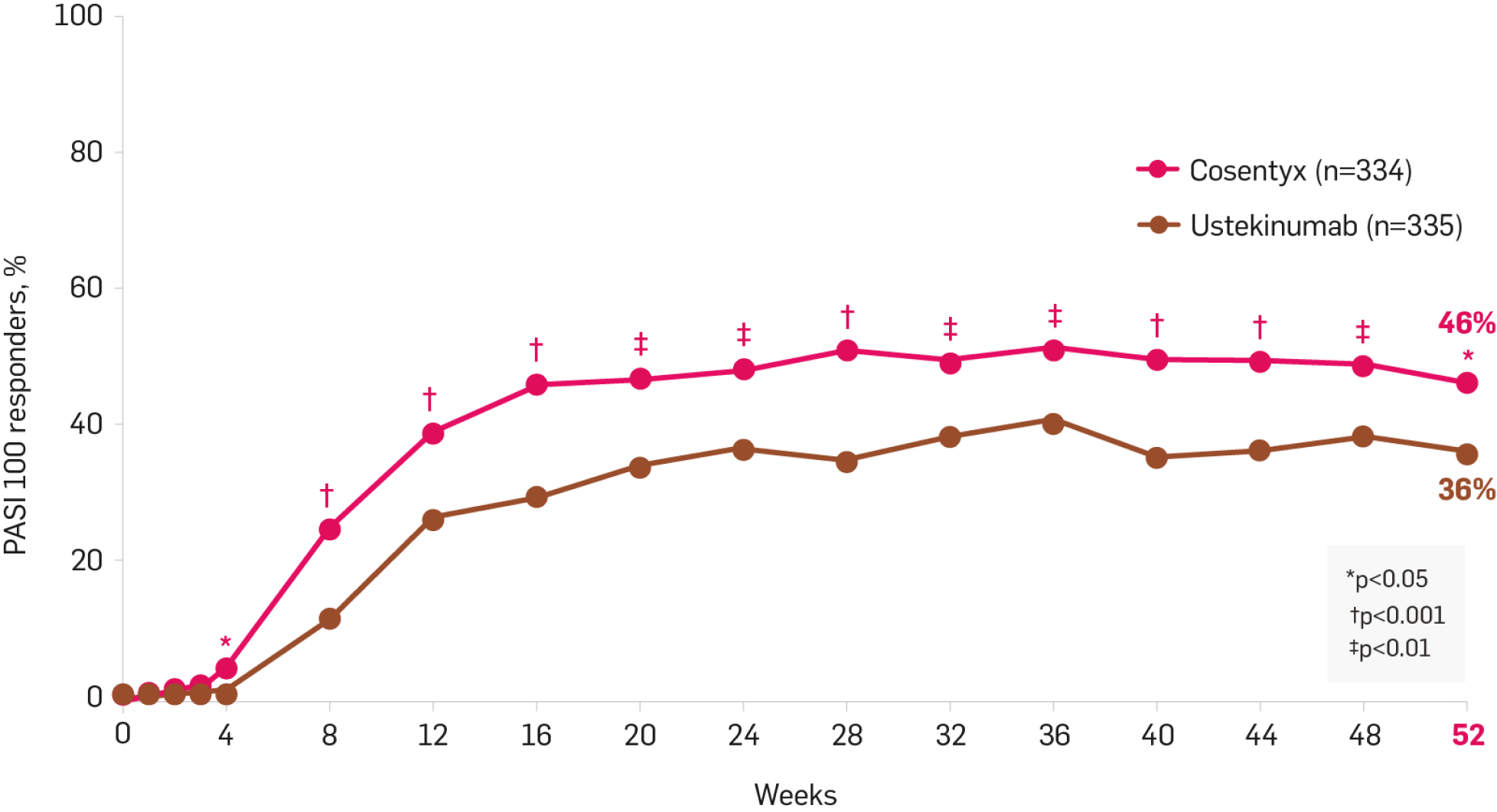

Cosentyx® (secukinumab): Mechanism of action
Cosentyx is indicated for the treatment of moderate to severe plaque psoriasis (PsO) in adults, children and adolescents from the age of 6 years who are candidates for systemic therapy; active psoriatic arthritis (PsA) in adult patients (alone or in combination with methotrexate [MTX]) when the response to previous disease-modifying anti-rheumatic drug therapy has been inadequate; active ankylosing spondylitis (AS) in adults who have responded inadequately to conventional therapy; active nonradiographic axial spondyloarthritis (nr-axSpA) with objective signs of inflammation as indicated by elevated C-reactive protein and/or magnetic resonance imaging evidence in adults who have responded inadequately to non-steroidal anti-inflammatory drugs; active moderate to severe hidradenitis suppurativa (HS; acne inversa) in adults with an inadequate response to conventional systemic HS therapy; active enthesitis-related arthritis (ERA) in patients 6 years and older (alone or in combination with MTX) whose disease has responded inadequately to, or who cannot tolerate, conventional therapy; active juvenile psoriatic arthritis (JPsA) in patients 6 years and older (alone or in combination with MTX) whose disease has responded inadequately to, or who cannot tolerate, conventional therapy.1,2
The Cosentyx mechanism of action works by blocking IL-17A, a key proinflammatory cytokine associated with inflammation in axSpA, PsA, PsO and HS1–14

Increased levels of IL-17A are found in the affected tissues of patients with axSpA, PsA,
PsO and HS1,2,8,15,16
How does Cosentyx work?
The active ingredient, secukinumab, mechanism of action works by targeting IL-17A, preventing it from binding to the IL-17A receptor.1,2 It acts downstream of several other biologics and inhibits IL-17A cytokines irrespective of adaptive or innate immunity origin.17,18
Cosentyx mechanism of action video
Watch the short video below to discover the mode of action of Cosentyx.
Through blocking IL-17A, Cosentyx works across the key manifestations of axSpA, PsA, PsO and HS1–9

Cosentyx’s mechanism of action may provide an alternative option for patients with an inadequate response to IL-12/231,2,4,18,19
Consider IL-17 MoA as an alternative option for patients with inadequate response to IL-12/231–9
CLEAR study: PASI 100 over 52 weeks (secondary endpoint)19

Graph adapted from Blauvelt A, et al. 2017.19
Starting at Week 4 and lasting through to Week 52, each dose of Cosentyx 300 mg resulted in a statistically significant improvement in PASI 100 response rates compared with ustekinumab 45 mg or 90 mg19
CLEAR primary endpoint: The proportion of patients achieving PASI 90 at Week 16 for Cosentyx 300 mg vs ustekinumab 45 mg or 90 mg was met by 79% vs 58%, respectively; p<0.000119
Cosentyx and ustekinumab exhibited comparable safety and tolerability profiles with no new or unexpected safety signals. The most common AEs for both were nasopharyngitis and headache19
CLEAR was a Phase IIIb, randomised, double-blind, head-to-head study comparing Cosentyx and ustekinumab at Week 52.*19
In the CLEAR study, Cosentyx demonstrated superior long-lasting skin clearance vs ustekinumab over 1 year19
BAD recommends a TNF antagonist or an IL-17 inhibitor (such as Cosentyx) as a first-line biologic for eligible adult patients with psoriasis and PsA20
Please note Cosentyx is only indicated for the treatment of active psoriatic arthritis in adult patients (alone or in combination with methotrexate) when the response to previous disease modifying anti-rheumatic drug (DMARD) therapy has been inadequate.1,2
Cosentyx is intended for use under the guidance and supervision of a physician experienced in the diagnosis and treatment of conditions for which Cosentyx is indicated. Please refer to the Cosentyx SmPC for full product information before prescribing.1,2
Therapeutic Indications1
Cosentyx is indicated for the treatment of moderate to severe plaque psoriasis (PsO) in adults, children and adolescents from the age of 6 years who are candidates for systemic therapy; active psoriatic arthritis (PsA) in adult patients (alone or in combination with methotrexate [MTX]) when the response to previous disease-modifying anti-rheumatic drug therapy has been inadequate; active ankylosing spondylitis (AS) in adults who have responded inadequately to conventional therapy; active nonradiographic axial spondyloarthritis (nr-axSpA) with objective signs of inflammation as indicated by elevated C-reactive protein and/or magnetic resonance imaging evidence in adults who have responded inadequately to non-steroidal anti-inflammatory drugs; active moderate to severe hidradenitis suppurativa (HS; acne inversa) in adults with an inadequate response to conventional systemic HS therapy; active enthesitis-related arthritis (ERA) in patients 6 years and older (alone or in combination with MTX) whose disease has responded inadequately to, or who cannot tolerate, conventional therapy; active juvenile psoriatic arthritis (JPsA) in patients 6 years and older (alone or in combination with MTX) whose disease has responded inadequately to, or who cannot tolerate, conventional therapy.1
*CLEAR was a Phase IIIb randomised, double-blind, head-to-head study comparing Cosentyx 300 mg (n=337) to ustekinumab 45 mg or 90 mg (n=339) over 52 weeks in patients with moderate to severe PsO. The primary endpoint was PASI 90 at Week 16. The main secondary endpoint was PASI 90 at Year 1. PASI 75/90/100 over time were also evaluated.19
AE, adverse event; ankylosing spondylitis; axSpA, axial spondyloarthritis; BAD, British Association of Dermatologists; ERA, enthesitis-related arthritis; HS, hidradenitis suppurativa; IL-17A, interleukin 17A; IL-23, interleukin 23; JPsA, juvenile psoriatic arthritis; MTX, methotrexate; NK, natural killer; nr-axSpa, active non-radiographic axial spondyloarthritis; PASI, psoriasis area and severity index; PsA, psoriatic arthritis; PsO, plaque psoriasis; SmPC, summary of product characteristics; TNF, tumour necrosis factor.
References
Cosentyx® (secukinumab) GB Summary of Product Characteristics.
Cosentyx® (secukinumab) NI Summary of Product Characteristics.
Zeichner JA, et al. J Clin Aesthet Dermatol 2016;9(suppl 6):S3–S6.
Lynde CW, et al. J Am Acad Dermatol 2014;71(1):141–150.
Keijsers RR, et al. Exp Dermatol 2014;23(11):799–803.
Mease PJ, et al. N Engl J Med 2015;373(14):1329–1339.
McInnes IB, et al. Lancet 2015;386(9999):1137–1146.
Mills KHG. Nat Rev Immunol 2023;23(1):38–54.
Fletcher JM, et al. Clin Exp Immunol 2020;201(2):121–134.
Lories RJ, et al. Nat Med 2012;18(7):1018–1019.
Smith JA, et al. Arthritis Rheumatol 2014;66(2):231–241.
Kehl AS, et al. Arthritis Rheumatol 2016;68(2):312–322.
McGonagle D, et al. Nat Rev Rheumatol 2015;11(12):731–740.
Baeten D, et al. N Engl J Med 2015;373(26):2534–2548.
Constantinou CA, et al. Ther Adv Musculoskelet Dis 2019;11:1759720X19895488.
Schön M & Erpenbeck L. Front Immunol 2018;9:1323.
Gorelick J, et al. Practical Dermatol 2016;12:35–50.
Krueger J, et al. Exp Dermatol 2023;00:1–14.
Blauvelt A, et al. J Am Acad Dermatol 2017;76(1):60–69.
Smith CH, et al. Br J Dermatol 2020;183(4):628–637.
UK | November 2024 | 452154
Adverse events should be reported. Reporting forms and information can be found at www.mhra.gov.uk/yellowcard. Adverse events should also be reported to Novartis online through the pharmacovigilance intake (PVI) tool at www.novartis.com/report, or alternatively email [email protected] or call 01276 698370.

